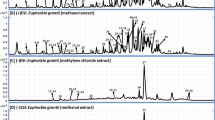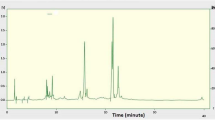Abstract
The present study is an attempt to investigate the efficacy of Triphala in ameliorating the hepatotoxic effects of bromobenzene (BB) in experimental rats. Hepatotoxicity was induced in rats by oral administration of BB (1.57 mg/kg b.w.) and Triphala was given orally at two doses of 250 and 500 mg/kg b.w. for a period of 8 days. The antioxidant status was studied by measuring lipid peroxidation, total reduced glutathione levels and enzymes such as catalase (CAT), superoxide dismutase (SOD), glutathione peroxidase (GPx) and glutathione-S-transferase (GST) in liver tissue homogenates. In addition, the levels of cytokines such as tumour necrosis factor-α (TNF-α) and interleukin-1β (IL-1β) were measured in serum. The hepatoprotective role of Triphala was compared with that of the standard hepatoprotective agent silymarin. The treatment of BB-intoxicated rats with Triphala showed significant (p < 0.05) increase in the antioxidant status and significant (p < 0.05) reduction in the levels of Tumour Necrosis Factor-α (TNF-α), Interleukin-1β (IL-1β). The histopathological findings further confirmed the protective role of Triphala against BB-induced hepatotoxicity in rats. From the results obtained in this study, it can be concluded that treatment with Triphala alleviated the hepatotoxic effect of BB in experimental rats.




Similar content being viewed by others
References
Anjana J, Monika B, Sangeeta S (2007) Protective effect of Terminalia bellerica Roxb. and gallic acid against carbon tetrachloride induced damage in albino rats. J Ethnopharmacol 109(2):214–218
Brodie B, Reid W, Cho A, Sipes G, Krishna G, Gillette J (1971) Possible mechanism of liver necrosis caused by aromatic organic compounds. Proc Natl Acad Sci 68:160–164
Casini A, Giorli M, Hyland RJ, Serroni A, Gilfor D, Farber JL (1982) Mechanisms of cell injury in the killing of cultured hepatocytes by bromobenzene. J Biol Chem 257:6721–6728
Chouhan B, Kumawat RC, Kotecha M, Ramamurthy A, Nathani S (2013) Triphala: a comprehensive ayurvedic review. Int J Res Ayurveda Pharm 4(4):612–617
Curtis JO, John PVH, Gary HP, Jeffrey MP (2011) Xenobiotic metabolism, disposition, and regulation by receptors: from biochemical phenomenon to predictors of major toxicities. Toxicol Sci 20(1):49–75
El-Sharaky AS, Newairy AA, Kamel MA, Eweda SM (2009) Protective effect of ginger extract against bromobenzene-induced hepatotoxicity in male rats. Food Chem Toxicol 47:1584–1590
Gandhi NM, Nair CK (2005) Radiation protection by Terminalia chebula: some mechanistic aspects. Mol Cell Biochem 277:43–48
Heinje WH, Slitt AL, Van BPJ, Groten JP, Klaassen CD, Stierum RH, Van Ommen B (2004) Bromobenzene-induced hepatotoxicity at the transcriptome level. Toxicol Sci 97:411–423
Hyun JL, Yeo KO, Marie R, Joong-Yeon L, Ji-Young H, Yoon et al (2007) The role of STAT1/IRF-1 on synergistic ROS production and loss of mitochondrial transmembrane potential during hepatic cell death induced by LPS/D-GalN. J Mol Biol 369:967–984
Jagetia GC, Baliga MS, Malagi KJ, Kamath MS (2002) The evaluation of the radioprotective effect of Triphala (an ayurvedic rejuvenating drug) in the mice exposed to radiation. Phytomedicine 9:99–108
Jayakumar T, Ramesh E, Geraldine P (2006) Antioxidant activity of the oyster mushroom, Pleurotus ostreatus, on CCl4-induced liver injury in rats. Food Chem Toxicol 44:1989–1996
Jie-Qiong M, Jie D, Li Z, Chan-Min L (2014) Ursolic acid protects mouse liver against CCl4-induced oxidative stress and inflammation by the MAPK/NF-B pathway. Environ Toxicol Pharm 37:975–983
Khandelwal S, Shukla LJ, Shanker R (2002) Modulation of acute cadmium toxicity by Emblica officinalis fruit in rat. Indian J Exp Biol 40(5):564–570
Liyun Y, Neil K (2009) Glutathione in liver diseases and hepatotoxicity. Mol Asp Med 30(1–2):29–41
Marc GS, George HL (1997) Xenobiotic-induced hepatotoxicity: mechanisms of liver injury and methods of monitoring hepatic function. Clin Chem 43(8B):1512–1526
Marklund SL, Marklund G (1974) Involvement of superoxide anion radical in the autooxidation of pyrogallol and a convenient assay for superoxide dismutase. Eur J Biochem 47:469–474
Moron MS, Depierre JW, Mannervik B (1979) Levels of glutathione, glutathione reductase and glutathione-s-transferase activities in rat lung and liver. Biochim Biophys Acta 582:67–78
Naik GH, Priyadarsini KI, Bhagirathi RG, Mishra B, Mishra KP, Banavalikar MM, Mohan H (2005) In vitro antioxidant studies and free radical reactions of Triphala, an Ayurvedic formulation and its constituents. Phytother Res 19(7):582–586
Nariya MB, Shukla VJ, Ravishankar B, Jain SM (2011) Comparison of gastroprotective effects of Triphala formulation on stress-induced ulcer in rats. Indian J Pharm Sci 73(6):682–687
Ohkawa H (1979) Assay for lipid peroxides in animal tissues by thiobarbituric acid reaction. Anal Biochem 95:351–358
Rasool M, Sabina EP, Lavanya K, Nithya P (2008) Therapeutic effect of Indian ayurvedic herbal formulation Triphala on acetaminophen-induced hepatotoxicity in mice. J Pharmacol Toxicol 2(8):725–731
Renaud HJ, Rutter A, Winn LM (2012) Assessment of xenobiotic biotransformation including reactive oxygen species generation in the embryo using benzene as an example. Methods Mol Biol 889:253–263
Romero FJ, Bosch MF, Romero MJ, Jareno EJ, Romero N, Marin et al (1998) Lipid peroxidation products and antioxidants in human disease. Environ Health Perspect 106(5):1229–1234
Rotruck JT, Pope AL, Ganther HE, Swanson AB, Hafeman DG, Hoekstra WG (1973) Selenium: biochemical role as a component of glutathione peroxidase purification and assay. Science 179:588–590
Sabina EP, Rasool M, Vedi M, Arulmani G (2013) Protective properties of traditional herbal formulation Triphala against D-galactosamine induced hepatotoxicity in mice. Int J Drug Dev Res 5(2):164–173
Sandhya T, Lathika KM, Pandeyb BN, Mishra KP (2006) Potential of traditional ayurvedic formulation, Triphala, as a novel anticancer drug. Cancer Lett 231(2):206–214
Saraswathi MN, Karthikeyan M, Kannan M, Rajasekar S (2012) Terminalia belerica Roxb.-A phytopharmacological review. Int J Res Pharm Biomed Sci 3(1):96–99
Shaifali G, Anuradha P, Suman K (2012) Triphala and its constituents ameliorate visceral adiposity from a high-fat diet in mice with diet-induced obesity. Altern Ther Health Med 18(6):38–45
Sherry JM, Mahima V, Udhaya LB, Blossom B, Agnes SK, Anne SST, Rassol M, Sabina EP (2014) Protective role of food supplement Spirulina fusiformis in chemical induced hepatotoxicity: a Bromobenzene model in rats. Int J Pharm Res 4(1):4–8
Singh DP, Govindarajan R, Rawat AKS (2008) High performance liquid chromatography as a tool for the chemical standardization of Triphala-an Ayurvedic formulation. Phytochem Anal 19(2):164–168
Sinha AK (1972) Colorimetric assay of Catalase. Anal Biochem 47:389–394
Valsaraj R, Pushpangadan P, Smitt UW, Adsersen A, Christensen SB, Sittie (1997) New anti-HIV-1, antimalarial and antifungal compounds from Terminalia bellerica. J Nat Prod 60:739–742
Varaprasad B, Prasanth KK, Chandrasekhar NK, Somasekhar P (2009) Antifungal activity of selected plant extracts against phytopathogenic fungi Aspergillus niger. Indian J Sci Technol 2(4):87–90
William HH, Michael JP, William BJ (1974) Glutathione S-Transferases the first enzymatic step in mercapturic acid formation. J Biol Chem 249:7130–7139
Xu C, Li CY, Kong AT (2005) Induction of phase I, II and III drug metabolism/transport by xenobiotics. Arch Pharm Res 28(3):249–268
Acknowledgments
The authors are thankful to VIT University for lab facilities and infrastructure.
Conflict of Interest
The authors do not have any conflict of interest.
Author information
Authors and Affiliations
Corresponding author
Rights and permissions
About this article
Cite this article
Baskaran, U., Rasool, M. & Sabina, E.P. Alleviation of the hepatotoxic effect of bromobenzene by the Indian traditional herbal formulation Triphala in experimental rats. Orient Pharm Exp Med 14, 369–374 (2014). https://doi.org/10.1007/s13596-014-0170-6
Received:
Accepted:
Published:
Issue Date:
DOI: https://doi.org/10.1007/s13596-014-0170-6




